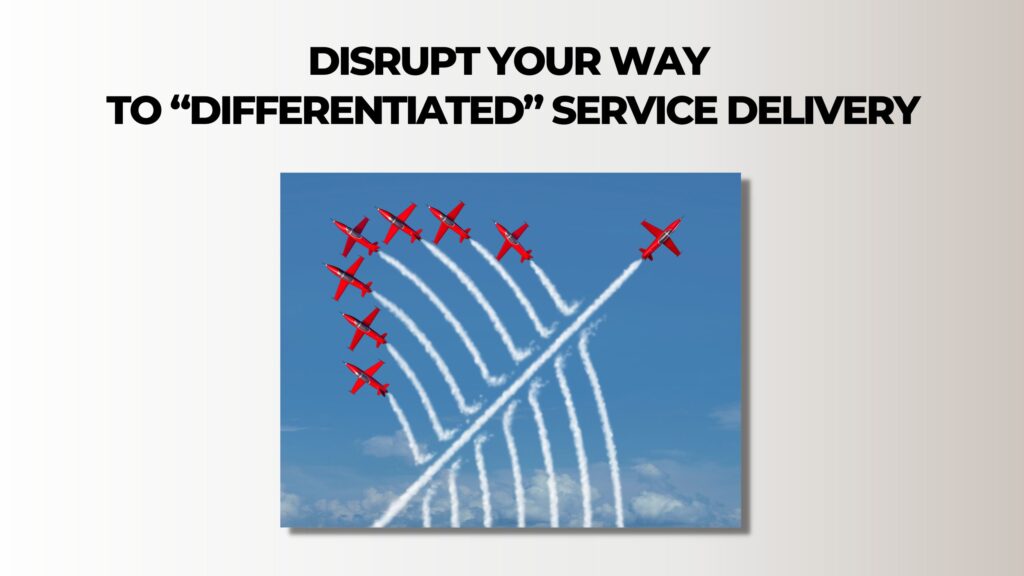I’m certain that all of us have encountered a customer experience that took our breath away for a moment and had us gushing over the details of the service delivery. In many cases, that experience would have become our new standard of excellence, against which all subsequent experiences would have been compared. It would have been a differentiated experience.
A differentiated experience is a superlative experience. When this experience is generated consistently, every time a customer interacts with the business, it remains memorable and top of mind for the customer. The payoff for the business is that it becomes elevated to “differentiated brand” status in the minds of its customer and, well, we know what happens going forward, with that relationship.
There’s a broad inventory of disruptions that lead to a “differentiated experience,” but the major ones include customer orientation, business model, leadership, manpower, culture and technology disruptions.
The businesses that deliver differentiated experiences are in the minority. Why? Because it takes a lot of sustained effort to achieve this result. It takes a certain kind of business that firstly, is willing to be educated on the mechanics of service excellence and secondly, is willing to institutionalize the right people and processes to sustain superlative customer outcomes.
It’s not a simple undertaking where the business clicks its heels and, voilà, the new experience emerges magically. It takes a business that makes disruption a way of life and continuous improvement, a living mantra.
There’s a huge need to listen to customers via traditional channels, social channels and through the creation of customer communities.
Disruption has developed a sort of negative reputation. Whilst it never enjoyed eminence as a desirable circumstance, the vicissitudes of the pandemic that caused widespread upheaval, created a rise in the level of distaste for any kind of disruption.
Yet, we do need to consider the upside of disruption, which when managed well, highlights the intersectionality of positive disruption and service excellence. There’s a broad inventory of disruptions that lead to a “differentiated experience,” but the major ones include customer orientation, business model, leadership, manpower, culture and technology disruptions. I’ve lifted out a couple for consideration.
The culture of a business should reflect the changing tapestry of its people, processes and practices, as these cultural markers evolve.
An early disruption has to be a shift in the entire view of the customer and how a business needs to redesign the relationship with its customers. There’s a huge need to listen to customers via traditional channels, social channels and through the creation of customer communities. Customers are vociferous in communicating their expectations and businesses will pay the price for treating customers carelessly.
Cultural transformation would be another essential disruption. The culture of a business should reflect the changing tapestry of its people, processes and practices, as these cultural markers evolve. A business is a living entity and should be completely preoccupied with continuously refreshing itself. Its internal ecosystem should be adaptive enough to embrace the most desirable norms and behaviours that reflect the modernity of the world, with all of its diversity and inclusiveness.
There’s the need for the strategic use of technology to ensure that internal value chains such as business development, marketing, sales and customer support, share a single view of the customer.
Technological disruption is now a major driver of business progress. There’s the need for the strategic use of technology to ensure that internal value chains such as business development, marketing, sales and customer support, share a single view of the customer. Getting this synchronization right minimizes the inhibitors to speed and responsiveness and supports the execution of accurate responses to customers’ needs.
Strategy disruption is often painful, but is absolutely necessary. Some leaders hold on for dear life to strategies that can cause impairment to the business, simply because they are emotionally wedded to the strategies. In our modern world, strategies need to be dynamic and not static, to allow for agility and ease of adaptability to sudden changes in the environment or to circumstances that affect the business. This capacity is even more applicable to those businesses that have “Agility” displayed prominently as one of their values.
The effective, modern-day leader has to be a change agent, a change leader and a change maker who takes both a short-term, as well as a long-term view of the future.
The final disruption that I will highlight is that of leadership disruption. The effective, modern-day leader has to be a change agent, a change leader and a change maker who takes both a short-term, as well as a long-term view of the future. Leading change requires leaving space for strategic flexibility as the business begins to strengthen or to scale-up.
There’s a compelling case for the value that carefully curated disruptions can add to existing business models. When executed well, intentional disruption strategies will enable a business to build a strong and vibrant internal ecosystem that is efficient, modern and customer-friendly.
Any business that is committed to stacking these building blocks of disruptive change, would be on its way to becoming a differentiated brand.
I think that it would be safe to say that the business would be well poised to disrupt its way to service excellence as well.

